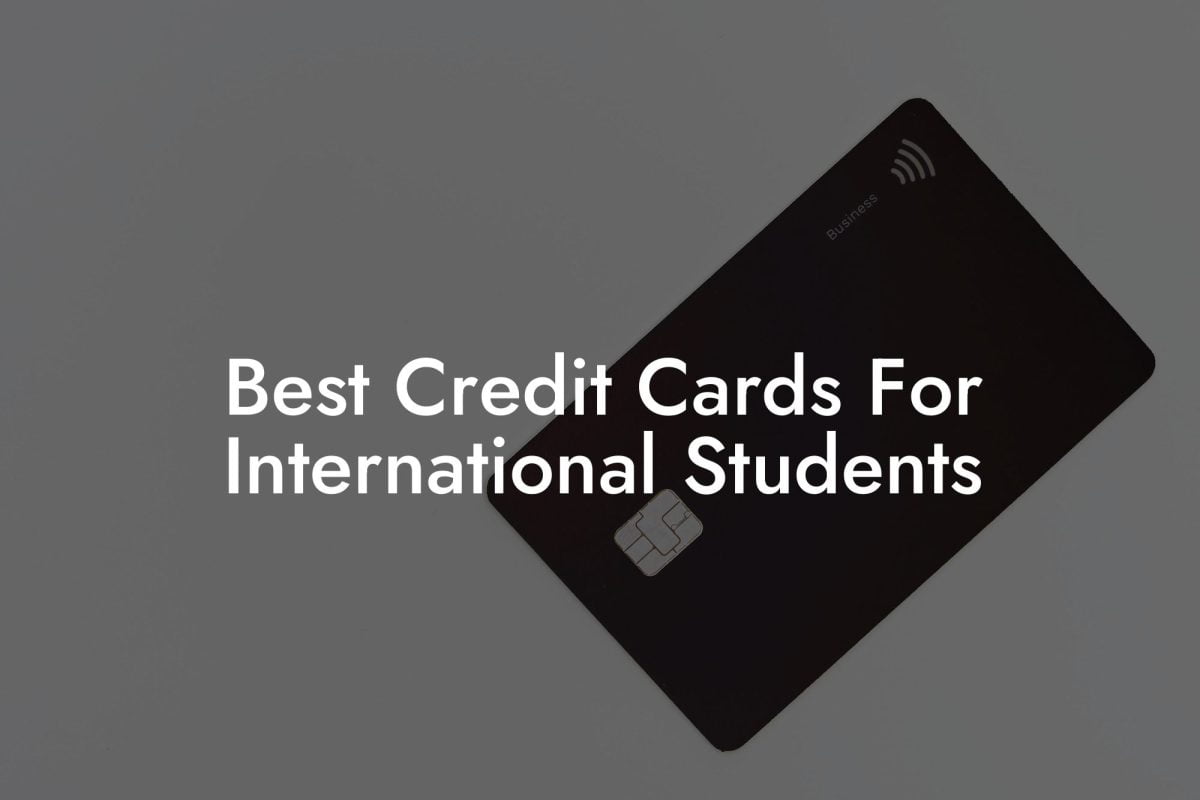So, you’re a student with less-than-stellar credit and thinking, “Hey, I could really use a credit card that won’t judge me for my past shopping sprees on ramen noodles!” Welcome to your comprehensive guide on Credit Cards For Bad Credit For Students, where we break down the choppy waters of credit, explain how you can get a card despite past mishaps, and have a few laughs along the way. Whether you're juggling tuition, textbooks, or an ever-growing collection of discount coupons, this guide is here to empower you to make smarter financial choices.
Credit Cards For Bad Credit For Students Table of Contents
What Exactly Are Credit Cards For Bad Credit For Students?
The Lowdown on Credit Scores and Why They Matter
How Do Credit Cards For Bad Credit For Students Work?
Benefits of Getting a Credit Card Even With Bad Credit
The Drawbacks—Let’s Keep It Real
Finding the Right Credit Card for You
Step-by-Step Guide to Applying for a Credit Card with Bad Credit
Building and Repairing Your Credit as a Student
Navigating the Pitfalls: What to Avoid on Your Credit Journey
Case Studies: Real Stories of Student Credit Comebacks
Leveraging Technology and Resources to Stay On Track
Managing Student Life: Balancing Finances, Studies, and Fun
Resources and Community Support: Your Next Steps
Long-Term Financial Strategies: Beyond Student Life
Expert Tips for Maintaining Financial Health as a Student
The Future of Credit: Trends Every Student Should Know
Integrating Credit Management Into Your Overall Financial Well-Being
Student Testimonials: Words from the Credit-Recovered
Credit Cards For Bad Credit For Students: A Recap of Your Journey
Frequently Asked Questions About Credit Cards for Bad Credit For Students
What Exactly Are Credit Cards For Bad Credit For Students?
In a perfect world, every student would have pristine credit scores and a credit card loaded with rewards. But let’s face it: juggling classes, part-time jobs, and the existential crisis of choosing between a night out and extra study hours is no walk in the park. For many college students, a less-than-stellar credit history isn’t an anomaly—it’s a rite of passage.
Credit cards for bad credit for students are designed specifically for individuals who may have minimal or damaged credit records. These cards provide a stepping stone into the world of credit, offering a chance to rebuild credit scores and learn the ropes of responsible financial management with manageable credit limits and user-friendly features.
They’re generally easier to qualify for than traditional credit cards and often come with terms that consider your unique student lifestyle. So if you’ve been turned down by the fancy cards because of a “little” hiccup in your credit past, these cards might be just what you need.
The Lowdown on Credit Scores and Why They Matter
Before diving headfirst into the realm of bad credit cards, it’s essential to understand why your credit score is the lecture you never wanted to attend. Your credit score is a three-digit number that lenders use to decide whether to trust you with a line of credit. For many, a score under 600 screams “Caution: Financial Tornado Ahead!”
But here’s the twist: even if your score is less than desirable, taking the right steps with a secured credit card, or a specific student card, can help you build credit over time. It all comes down to responsible usage, timely payments, and keeping your credit utilization in check.
Think of your credit score as an academic GPA. A few B’s and C’s might haunt you initially, but if you keep putting in the study hours (or in this case, positive financial decisions), you’ll see that number improve!
How Do Credit Cards For Bad Credit For Students Work?
If you’re picturing a magical card that will instantly transform your financial destiny, hold that thought. Here’s the real scoop: these cards often come with lower limits and higher interest rates compared to premium cards. But don’t let that discourage you—these are essentially training wheels for your financial journey.
Many of these cards are structured similarly to secured credit cards. This means you’ll typically need to put down a security deposit that acts as your credit limit. The deposit minimizes the lender’s risk and helps you build up a favorable payment history. Over time, with responsible use, some issuers may graduate you to an unsecured card.
And while rewards programs for these cards may not be as flashy as those on higher-tier products, the real reward lies in learning to manage your money responsibly while gradually earning the trust of future lenders.
Benefits of Getting a Credit Card Even With Bad Credit
It might feel like a paradox that a student with bad credit should even consider a credit card. Yet, there are several compelling benefits:
- Building Credit History: Every responsible purchase and timely payment builds your credit, showing future lenders you’re on the path to financial maturity.
- Teaching Financial Responsibility: Managing a credit card gives you firsthand experience in budgeting and financial planning, skills that will serve you well long after graduation.
- Emergency Cushion: A credit card can be a lifesaver during an unexpected emergency when cash flow is tight—even if you’re mindful about not overspending.
- Access to Essential Resources: Some cards offer additional features like mobile banking, budgeting tools, and even discounts on student essentials.
- Transition to Better Offers: With improved credit over time, you could eventually qualify for cards with lower interest rates and more robust rewards.
Ultimately, while the journey might start with a card that has higher fees or lower limits, every responsible move you make now brings you one step closer to financial freedom.
The Drawbacks—Let’s Keep It Real
It wouldn’t be a balanced discussion if we didn’t highlight the potential downsides:
- High Interest Rates: Often, cards designed for bad credit come with higher APRs, so carrying a balance can get expensive fast.
- Lower Credit Limits: These cards typically come with modest limits, which might restrict your spending power but also help contain your debt.
- Fees: Some cards may assess annual fees or maintenance fees. Always read the fine print to understand what you’re getting into.
- Risk of Debt Accumulation: It’s easy to fall into the trap of overspending. Use the card wisely and always pay off the balance in full whenever possible.
Understanding these risks is key. By using the card as a tool for improvement rather than a crutch, you can navigate the potential pitfalls and come out stronger on the other side.
Finding the Right Credit Card for You
Now that we’ve covered the basics, the million-dollar question is: How do you find the best credit card for bad credit as a student? The answer lies in doing your homework. Here are some factors to consider:
Credit Requirements
Look for cards that are designed for applicants with little-to-no credit or bad credit. Read the eligibility criteria carefully, as some cards are specifically tailored for students or those in your financial situation.
Secured vs. Unsecured Options
While secured credit cards (where you deposit funds as collateral) are the norm for those with bad credit, a few unsecured options might be available. The secured option tends to be easier to obtain and is a common starting point for building credit.
Fees and Interest Rates
You don’t want to be hit with hidden fees, so scour the terms for details on annual fees, late payment fees, and the APR. Even if you’re just starting out, a card with a slightly higher fee might be worth it if it offers better tools for credit building.
Additional Features
Some cards come with extra perks like free credit score monitoring, budgeting tools, or even cashback on select purchases. While these features might not be the main attraction, they definitely add value.
User Reviews and Ratings
Reviews can give you an inside look at how helpful a card is for real students like you. Look for reviews that detail the signup process, ease of customer service, and practical experiences with card usage.
Take your time to compare options based on these criteria, and remember: sometimes the best deal isn’t the one with the flashiest rewards, but the one that offers steady, manageable growth in your credit history.
Step-by-Step Guide to Applying for a Credit Card with Bad Credit
Ready to take the plunge? Here’s a straightforward, no-nonsense guide to applying for a credit card when your credit history might raise a few eyebrows:
Step 1: Check Your Credit Report
First things first: know where you stand. Get a copy of your credit report from the major bureaus. This will help you understand your current profile and dispute any inaccuracies that might be dragging your score down.
Step 2: Compare Your Options
Do some online research and compare cards designed for individuals with bad credit. Pay close attention to features like credit limits, fees, and additional perks. Use comparison tools and read user reviews to inform your decision.
Step 3: Gather Your Documentation
Just like applying for a job, you’ll need documents to verify your identity and income. Gather your student ID, proof of enrollment, a copy of your social security number, and any recent pay stubs. Being organized before you apply can streamline the process.
Step 4: Submit Your Application
Fill out the application carefully and honestly. Double-check your information and hit submit. Some applications may offer an immediate decision, while others might take a few days to process.
Step 5: Secure Your Deposit (If Applicable)
For secured credit cards, be prepared to make a security deposit. This deposit often equals your credit limit and is refundable if you manage your account responsibly over time.
Step 6: Use the Card Responsibly
Once approved, the real journey begins. Use the card for small, manageable purchases, and always pay your bill on time to avoid fees and build a positive payment history.
Remember, this isn’t a get-rich-quick scheme—it’s about taking controlled steps that gradually improve your financial reputation. Celebrate small victories along the way. Every on-time payment is a win!
Building and Repairing Your Credit as a Student
Think of your credit as a muscle that needs regular exercise to get stronger. Whether you’re starting from scratch or trying to mend a few financial bruises, there are practical strategies to build or repair your credit:
Budgeting Basics
Create a budget that outlines your income, expenses, and financial goals. This will help you manage your spending and ensure that you have enough funds to pay off your credit card balances in full every month.
Track Your Spending
Use budgeting apps or even a spreadsheet to monitor where your money is going. Tracking your expenses can help you identify areas where you can cut back, ultimately freeing up funds to pay down debt.
Set Up Payment Reminders
Late payments can be the arch-nemesis of your credit score. Set up reminders or automatic payments to ensure that you never miss a due date. Timely payments are the cornerstone of a healthy credit history.
Keep Your Credit Utilization Low
Ideally, you should use no more than 30% of your available credit at any given time. This ratio shows lenders that you’re managing your resources wisely.
Monitor Your Credit Progress
Regularly check your credit report using free services. This will help you track your progress and catch any errors early. Remember: knowledge is power when it comes to building your financial future.
Slowly but surely, your discipline will pay off, transforming your credit score from a cautionary tale into a shining example of financial resilience.
Navigating the Pitfalls: What to Avoid on Your Credit Journey
While the journey to better credit is paved with opportunities, there are also a few traps that you need to watch out for to avoid undermining your progress:
Impulse Spending
Those inevitable moments when you see a flashy gadget or a must-have accessory can be hard to resist. However, impulse purchases on your credit card can quickly rack up interest if you’re not careful. Practice mindful spending and always ask, “Do I really need this?”
Carrie a Balance
It’s tempting to let a small balance roll over from month to month, but carrying a balance typically incurs interest, which can spiral out of control. Try to pay off your balance in full whenever possible.
Multiple Applications
Applying for too many credit cards at once can hurt your score. Each hard inquiry can lower your score slightly, so space out your applications and choose wisely.
Ignoring the Fine Print
Every agreement has its hidden clauses. Take the time to read the terms and conditions, understand the fees, and be aware of the interest rates so that there are no surprises down the line.
By steering clear of these pitfalls, you’ll build a solid financial foundation that sets you up for future success—even if your start was a bit bumpy.
Case Studies: Real Stories of Student Credit Comebacks
Nothing beats a good success story. Let’s take a look at a few case studies that illustrate how students have managed to turn their credit disasters into triumphant financial comebacks:
Case Study 1: Alex’s Journey from Zero to Hero
Alex, a freshman dorm dweller, was notorious for maxing out his prepaid debit card on late-night pizza orders. After a series of unavoidable overdrafts and a credit mishap or two, Alex decided it was time to get serious about his financial future. He started with a secured credit card designed for bad credit, set up a strict budget (cutting down on extra cheese orders), and diligently paid off his balance every month. Over time, Alex’s consistent efforts raised his credit score, and he eventually qualified for an unsecured card with better rewards.
Case Study 2: Taylor’s Cautionary Tale Turned Triumph
Taylor had a rocky start in college with impulsive online shopping sprees that left her with a less-than-stellar credit score. Realizing the long-term consequences, she enrolled in financial literacy workshops offered by her university, learned the art of budgeting, and switched to a credit card designed with students in mind. With accountability partners and a newfound love for careful spending, Taylor not only improved her credit score but also managed to save up for a much-needed study abroad program.
Case Study 3: Jordan’s Strategic Overhaul
Jordan had always been skeptical of the whole credit system until a rogue late fee nearly derailed his graduation dreams. Determined to fix his financial habits, he opted for a secured credit card for bad credit and made small, strategic purchases that he could pay off immediately. Over several semesters, Jordan’s responsible behavior turned a rocky credit history into a story of redemption, providing him with better job offers and higher credit limits in the future.
These stories show that regardless of your past, with determination and smart choices, it’s absolutely possible to rebuild your financial standing—even if you’re just starting out as a student.
Leveraging Technology and Resources to Stay On Track
In our hyper-connected world, technology can be your best friend when it comes to managing your credit. There are plenty of digital tools out there that can help you keep tabs on your finances, track your spending, and even boost your credit score.
Budgeting and Expense Tracking Apps
Apps like Mint, YNAB (You Need A Budget), and PocketGuard allow you to track every purchase—from that essential coffee run to the inevitable textbook splurge. With these tools, budgeting becomes less of a chore and more of a lifestyle habit.
Online Credit Score Monitoring
Many credit card companies and independent services let you check your credit score for free. Staying informed means you can catch errors early, celebrate your milestones, and know exactly when it’s time to apply for a better card.
Digital Payment Reminders
Let technology handle those pesky due dates with mobile alerts and automatic payments. Whether you’re a night owl pulling all-nighters or an early bird, digital reminders ensure you never miss a payment.
Embracing these digital resources doesn’t just help you stay organized—it empowers you to take charge of your financial future with confidence.
Managing Student Life: Balancing Finances, Studies, and Fun
Let’s be honest: being a student is hard work. Between juggling classes, assignments, extracurricular activities, and the occasional attempt at a social life, your finances might not be your top priority. But here’s the secret—learning to balance your budget now sets you up for a smoother journey long after graduation.
Look at your credit card as a training ground for mastering financial discipline. Use it for everyday essentials—groceries, transportation, study supplies—and avoid using it as a ticket to endless parties or expensive gadgets. With proper management, you can enjoy the perks of credit while keeping your debt in check.
Moreover, many student-focused credit cards offer additional perks like discounts at popular retailers, cashback on dining, and even loyalty rewards that can ease some of student life’s wrinkles. Just remember: whenever you’re tempted to splurge, ask yourself, “Will this help build my future credit success or is it a short-term treat?”
Resources and Community Support: Your Next Steps
Financial literacy isn’t a solo journey—a supportive community can help you navigate the ups and downs of your credit-building adventure. Here are some resources and communities that can provide valuable insight:
Campus Financial Literacy Workshops
Many universities now offer workshops or seminars on personal finance. From budgeting basics to understanding credit, these sessions can demystify the process and help build a supportive network.
Online Financial Forums and Blogs
Websites like Reddit’s r/personalfinance, The College Investor, and NerdWallet offer real-world advice, user experiences, and detailed guides on managing student finances.
Credit Counseling Services
For personalized advice, consider reaching out to a credit counselor. Many non-profit organizations offer free or low-cost counseling that can help you set up a realistic budget and craft a plan to rebuild your credit.
Mobile Apps and Financial Tools
As mentioned earlier, tools like Mint, YNAB, and Credit Karma can help you monitor your progress, set reminders, and track your financial habits effectively.
With these resources, you'll always have a helping hand to guide you through the complexities of managing student finances. Remember, every great journey is supported by a community that lifts you up and helps you stay focused.
Long-Term Financial Strategies: Beyond Student Life
While your immediate goal is to secure a credit card and build your credit history, it’s important to have your eyes on the long-term prize: financial freedom. Here are some strategy pointers for beyond your student years:
Transitioning from Secured to Unsecured Cards
As your credit score improves, you might find opportunities to upgrade to unsecured cards with better rates and rewards. The key is to consistently demonstrate responsible usage and timely payments.
Investing in Financial Education
Continue learning about personal finance—read books, attend seminars, or subscribe to reputable financial blogs. The more you know, the better equipped you’ll be to make savvy financial decisions.
Establishing Emergency Savings
A good credit card is a helpful tool, but it shouldn’t be your only safety net. Start building an emergency fund so that unexpected situations don’t force you into harmful debt cycles.
Diversify Your Financial Portfolio
Once you’re out of school and established in your career, explore other financial instruments like student loans refinancing, auto loans, or even investments. Building credit is just one piece of the financial success puzzle.
Long-term success lies in a holistic strategy that combines credit management, savings, and informed investments. Each smart decision today lays the path for a wealthier tomorrow.
Expert Tips for Maintaining Financial Health as a Student
It’s one thing to get that credit card in hand, but another entirely to master the art of juggling life’s unexpected expenses. Here are some practical, expert-approved tips to keep you in the financial green:
- Pay More Than the Minimum: Even if you can only afford a little extra each month, paying more than the minimum helps chip away at that balance—and the interest will thank you later.
- Set Realistic Budgets: Know your limits. Whether it’s your monthly allowance or your part-time job income, having a clear monetary cap can keep those spontaneous buys in check.
- Automate Payments: Use technology to your advantage. Automate your credit card bills, so the due dates don’t sneak up on you.
- Keep an Eye on Your Credit Utilization: Avoid maxing out your card—even if it tempts you. A lower utilization ratio can significantly boost your credit score.
- Educate Yourself Continuously: Stay updated on financial trends, take up seminars, ask questions, and be proactive about your financial education.
With these tips in your back pocket, you’ll not only make smarter choices but also avoid common pitfalls that have tripped up many before you.
The Future of Credit: Trends Every Student Should Know
The world of credit is evolving fast, with technological advances and shifting economic policies shaping the future of lending. Here’s what students should keep on their radar:
Digital Wallets and Mobile Payments
With the growing popularity of apps like Apple Pay, Google Wallet, and others, your credit card might soon be just one tap away on your smartphone. Embracing these tools can streamline payments and help you track your spending in real time.
Credit Score Innovations
New models and alternative data methods are being developed to assess creditworthiness. This means that even if you have a limited credit history or a few blemishes in your record, emerging practices might give you a fair shot at better offers in the near future.
Sustainable Financial Practices
As more young people shift towards sustainability, expect to see credit products that reward environmentally friendly spending habits. Imagine earning extra points for using public transport or shopping at eco-friendly stores!
Keeping an eye on these trends not only prepares you for changes in the credit landscape but also positions you to take advantage of innovative products and policies as they emerge.
Integrating Credit Management Into Your Overall Financial Well-Being
Managing credit isn’t an isolated activity—it’s part of your overall financial health. When you integrate credit management into your life, it complements other aspects of your finances and sets a foundation for long-term stability.
Emergency Funds and Credit
Always have a rainy-day fund separate from your credit line. This separation can ensure that you aren’t forced to rely on high-interest debt when unexpected expenses hit.
Investments and Savings
Even as you work to improve your credit, think about setting aside a little for future investments. Whether it’s for further education, a down payment on a home, or retirement, every bit counts. The habit of saving will supplement your credit-building efforts in remarkable ways.
Balancing Debt and Lifestyle
It’s all about balance—using debt strategically without letting it control your life. Use credit as a tool, not a crutch, so you can enjoy your student life while building a strong financial future.
The real magic happens when all your financial pieces—credit, savings, and responsible spending—mesh perfectly to create a secure and flourishing future.
Student Testimonials: Words from the Credit-Recovered
Let’s wrap things up by hearing from students who’ve been in your shoes. Their stories are not just inspiring—they’re testament to the fact that even rocky financial beginnings can lead to stellar futures.
“From Zero to Credit Hero” – Morgan’s Story
Morgan, a junior balancing a full course load and part-time work, once had a credit score that made lenders cringe. With discipline and the help of a secured card, Morgan slowly built a solid payment history and improved their score. “It wasn’t easy, but every on-time payment felt like a tiny victory,” Morgan says with a smile.
“Learning to Budget and Build Credit” – Sam’s Insight
Sam, a freshman who admits to having once overindulged in online shopping (hello, trendy sneakers!), used his first credit card as a tool for self-discipline rather than indulgence. By sticking to a rigorous budget and using mobile payment reminders, Sam not only built credit but also learned valuable budgeting skills.
“The Journey is Worth It” – Riley’s Reflection
Riley, a senior with a tumultuous credit past, now champions financial literacy on campus. “Understanding how credit works changed my outlook entirely. Today, my card is a tool—one that has empowered me to plan for my future,” Riley asserts.
These testimonials are proof that with the right mindset, even a rough start can lead to financial triumph. Their journeys highlight that each step on this path is a building block towards a better future.
Credit Cards For Bad Credit For Students: A Recap of Your Journey
We’ve taken a deep dive into the world of credit cards designed for students with bad credit: from understanding credit scores, finding the right card, navigating the application process, and harnessing technology, to integrating long-term financial strategies. This guide isn’t just about surviving your student years—it’s about thriving and laying a brick-by-brick foundation for a prosperous financial future.
Each decision you make—from choosing a secured card to automating your payments—propels you toward improved credit and greater financial independence. The journey may have its ups and downs, but with every lesson learned, you’re crafting a narrative of resilience and resourcefulness that will serve you for the rest of your life.
Remember, a credit card is not just a piece of plastic—it’s a key to unlocking the door to financial opportunity. Embrace your mistakes, learn from them, and watch as your credit score transforms into a testament of your hard work and dedication.
Frequently Asked Questions About Credit Cards for Bad Credit For Students
Here are answers to some of the most common questions about credit cards for students with bad credit:
1. What is a student credit card for bad credit?
It’s a credit card designed specifically for students who have limited or damaged credit history. These cards typically offer lower credit limits, a secured deposit option, and flexible terms to help you build a positive credit history.
2. How can using a secured card improve my credit?
By making regular, on-time payments and keeping your credit utilization low, you build a positive payment history, which in turn boosts your credit score over time.
3. Are there any hidden fees or pitfalls I should be aware of?
Some cards may charge annual fees or maintenance fees, and they often come with higher interest rates. Always read the terms carefully to ensure you understand all the costs involved.
4. Can I use a student credit card for emergencies?
Absolutely. A credit card can serve as a financial safety net during emergencies, provided you use it responsibly and pay off the balance promptly to avoid debt accumulation.
5. How long does it take to improve my credit score with a secured card?
With consistent, on-time payments and responsible usage, you may start to see improvements in your credit score within six months to a year.
6. Can these cards eventually lead to opportunities for higher credit limits?
Yes. Many issuers review your account after a period of responsible usage, and you might be offered an upgrade or a higher limit as your credit history improves.
7. Where can I find more resources on building credit as a student?
Numerous online forums, university financial literacy workshops, and credit counseling services are available to help you navigate the journey of building better credit.
Your Path Forward to Financial Empowerment
Taking control of your credit is a journey—a series of small, calculated steps that add up to monumental progress over time. With the right credit card for bad credit tailored for your student lifestyle, you’re not only paving the way for a brighter financial future but also gaining invaluable lessons in money management along the way.
Embrace the challenge, celebrate the victories, and remember: every payment made on time brings you closer to the financial freedom you deserve. Cute ramen dinners might have funded some wild nights, but now’s the time to invest in YOUR future.
Whether you’re a freshman just starting out or a senior ready to graduate into the world of grown-up financial responsibilities, this guide is your trusty companion. Apply these actionable tips, learn from real-life student experiences, and let your newfound financial savvy propel you toward a successful future.
So, what are you waiting for? Seize the opportunity to rebuild your credit, learn the ropes of financial independence, and step confidently into a future where every decision is an investment in your dreams.













